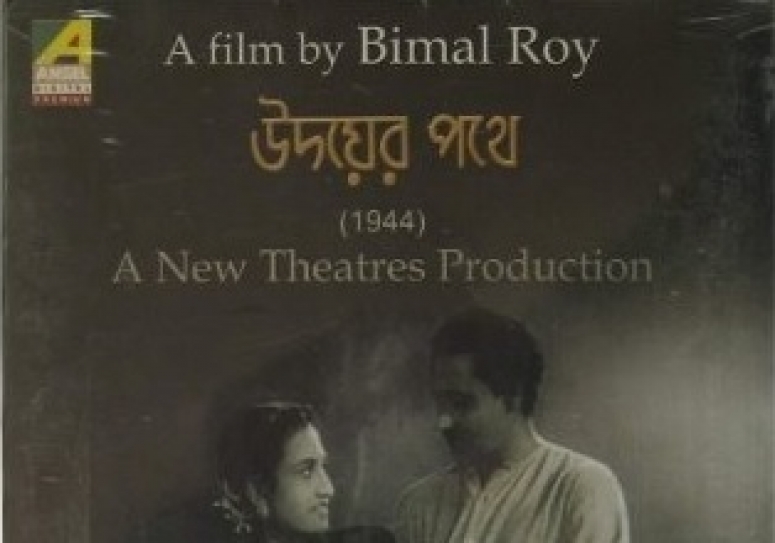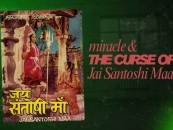
Udayer Pathe - A Star Is Born
by Rinki Roy Bhattacharya December 3 2016, 6:41 pm Estimated Reading Time: 6 mins, 24 secsWith Udayer Pathe, a new star was born – the name was BIMAL ROY.
As cinematographer, that star quality was evident after he shot P.C .Barua’s MUKTI. Deservedly, Barua celebrated his handsome young cinematographer, Bimal Roy, by splashing his name on MUKTI’s bill boards along with stars. I doubt very much this incredible phenomenon of mentioning the cinematographer with stars, has been repeated anywhere in the world. But the meteoric journey of director Bimal Roy begins with the 1944 film Udayer Pathe. Indeed that film maker was destined to change the contours of Indian cinema. Early Film acting, if we recall, was theatrical, melodramatic. The shift came after Udayer Pathe. Acting became natural and “wholly suited to cinema” observed Satyajit Ray. Growing up in that charmed era, in the glow of the film’s limelight – I witnessed its sweeping impact on Bengali society. The film ran nonstop for one whole year in Kolkata’s Chitra cinema. Talked about enthusiastically in posh drawing rooms, women wanted to dress and speak like the heroine Binota Ray. Till date New Theatre’s most successful film, it compelled the studio to remake the Hindi version HAMRAHI within two years. HAMRAHI created another historic chapter…given a tumultuous release in all over India as far as Lahore which was in north India. People were in disbelief. Could a film move them so powerfully? And can a film be so closely resemble life? Someone once remarked that if a film moves even two people, it is to be considered extraordinary. To think that this film moved an entire generation of movie goers – and future movie makers - is an incredible phenomenon.
I have met people who watched HAMRAHI 20 times. Met euphoric Bengalis who cannot stop talking about Udayer Pathe. Whose lives were touched by its humanistic ideology. These days we hear endless debates about what constitutes nationalism. Here is a film that has the answer. Nationalistic fervour flowed in every vein of Udayer Pathe .It’s aura spread from door to door in pre Independent India from the film.
Young progressive thinkers, intellectuals, writers , the future Ritwick Kumar Ghataks, Satyajit Rays, Tapan Sinhas, Mrinal Sens, Nabendu Ghoshs were inspired by Udayer Pathe. Many later joined Bimal Roy. Ritwick Ghatak, for example, assisted him in Tathapi made in Kolkata. Wrote the astonishing Madhumati. Tapan Sinha was Roy’s sound recordist and Nabendu Ghosh remained Bimal Roy’s screenplay writer. On the other side, the acclaimed Satyajit Ray aspired to write for Roy. In his remarkable piece My Film Guru ,Nabendu Ghosh recalled seeing lathi charge outside a Rajshahi theatres and wrote :“I saw a serpentine queue for tickets outside a cinema hall. Then I saw booklets of Udayer Pathe hanging like festoon in corner shops! Never did a film create this unbelievable impact , it was something unheard of!! After watching Udayer Pathe, I decided on the spot , if I ever joined films, it will only be to work with this Bimal Roy”
In Udayer Pathe the prevalent mood is of political dissent. Conceived in that mood the film confronts the elite class of Westernised Indians, who aped British rulers. Many of us would, I know, identify with the honest journalist who challenges the insensitivity of the rich, and powerful. What never fails to amaze are the many layers of social fabric Udayer Pathe engages with. The film addresses plagiarism, copyright infringement, trial by the media, gender sensitivity, class chasm, workers’ rights, and the naiveté of the ordinary middle class victims of shrewd manipulation by the wealthy. So many relevant issues set against the landscape of the 1943 manmade Bengal famine. The film’s dialogues sound are written with total irreverence .They are witty, cheeky – yet they do not resort to vulgarity. On the contrary, Udayer Pathe is written with an ear for literary finesse. So popular was the entire audio track of the film, that the famous Hindustan Record company released the film’s track 75 rpm records. Radio plays were produced that ran on the radio for days. Records sold like hot cakes. This must be the ONLY film to enjoy that unique privilege. Arguably, Udayer Pathe is Bimal Roy’s most radically political film. He plunges into the subject with supreme confidence. The film, today’s audience discovered with surprise, is incredibly modern. Watching it now, people are forced to recognise its socio economic relevance.
Bimal Roy never hesitated to raise his voice against all forms of social discrimination. He spoke against injustice through his enduring works. He did not make loud noise or posture about his beliefs. He communicated his politics discreetly, with utmost dignity. Imaged them through light n shade glorious images. Like him, many his male characters are refined, sophisticated, and extremely decent. Take Anup Lekhak of Udayer Pathe, or Adhir of Sujata, or the jail handsome doctor of Bandini. Each one of them ushers in social change with the choices they make. This reflects particularly in their choice of a life partner, their unshaken conviction to make the difference. The galaxy of Bimal Roy characters are real people, they represent middle class aspirations, speak the language we comprehend.
I truly believe Bimal Roy was the first – if not the only – Indian film maker to consistently question social injustice. His films portray a borderless society. Born into the feudal class he did not belong to that class. In fact, he disowned his ancestral roots film after film, portraying the landed gentry as cold blooded oppressors. He does this without demonising any one. Except perhaps the character of Ugranarayn, the vile Madhumati villain. Madhumati however belongs to a different genre altogether. Even the hardened pickpocket in Do Bigha Zamin is redeemed when he financially helps Kanhaiya. So is the Aunt in Sujata , she is full of superstation about Dalits. Finally she surrenders due to her affection and is thus redeemed.
Why does a Bimal Roy film still bring back droves of watchers? Or they have the ability to make us wipe our tears silently in the darkness of a movie theatre? Perhaps even shames us? In his films we rediscover the most cherished human qualities. Qualities we have erased systematically from our psyche. Bimal Roy’s films radiate with compassion, with concern, with tender ness, also his wry humour. Bimal Roy’s inclusive world is peopled with honourable individuals we ought to emulate, no, we ought to revere. Not to forget, each of his films resonate with haunting unforgettable musical scores that bond people of all ages.
The Supreme Court has just passed an order making it compulsory to play our National Anthem JANA GANA MANA before film shows. All theatre exits will be shut. Indians have to be shaken into Nationalistic fervour by listening to National anthem every time they watch a movie.
In this respect UDAYER PATHE becomes a trend setter. When the Indian National Anthem did not exist, a young film maker, chose Tagore’s Jana Gana Mana as his title music. He did not do this to cram down patriotism. Jana gana Mana was the signature tune to his theme of class discrimination. And so every time Udayer Pathe starts people rise on their feet! The film and its maker are given a standing ovation. The film’s title music is an orchestral version of Tagore’s Jana gana mana composed by R.C.Boral(India’s first Dada Saheb Phalke recipient)
This was no mere co incident, it is the a prophetic sign.
A star was born with UDAYER PATHE




-173X130.jpg)

-173X130.jpg)
-173X130.jpg)
-173X130.jpg)
-173X130.jpg)
-173X130.jpg)
-173X130.jpg)